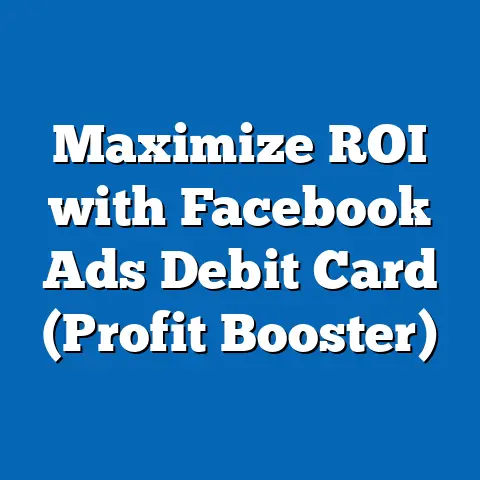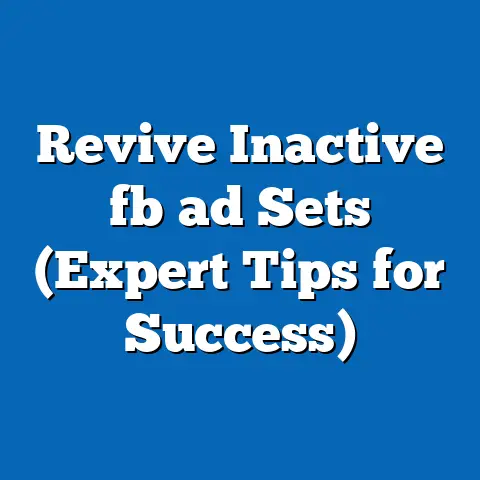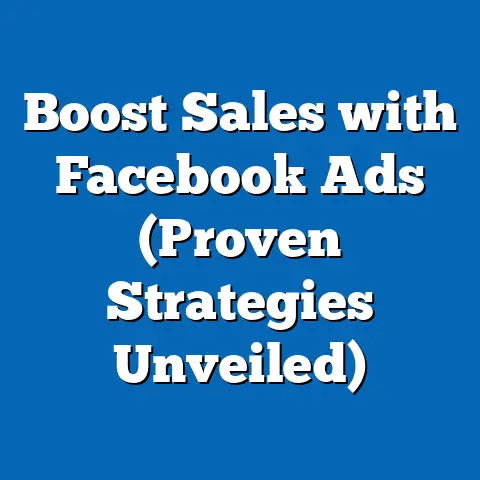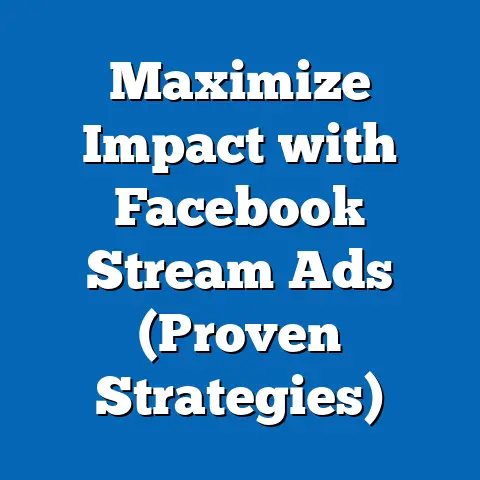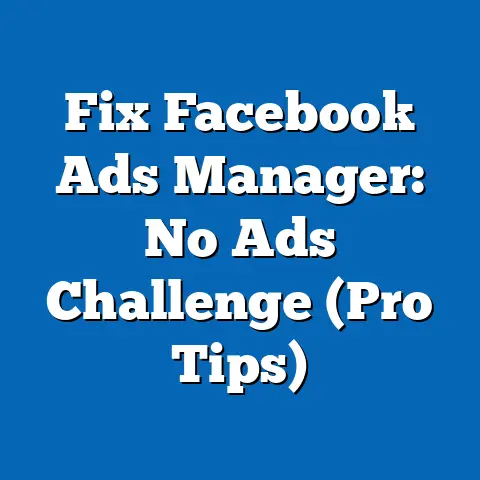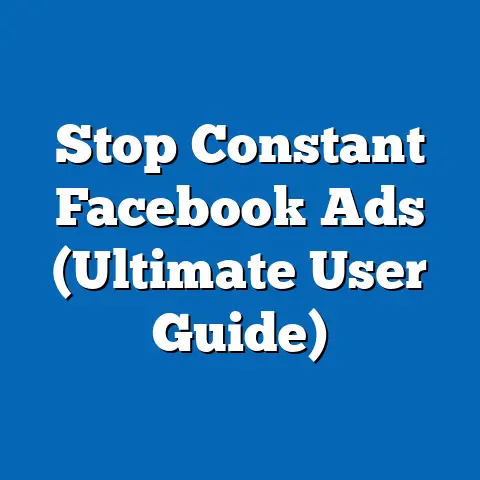Mastering Facebook Ads Post-Ad Blocker (Game-Changing Strategies)
The digital advertising landscape is constantly evolving, and one of the biggest challenges marketers face today is the rise of ad blockers. It’s easy to fall into the trap of believing that Facebook ads are becoming obsolete, rendered ineffective by these ubiquitous tools. I’ve heard countless marketers lament the perceived decline in reach and engagement, attributing it solely to ad blockers. But I’m here to tell you that the rumors of Facebook ads’ demise are greatly exaggerated.
While ad blockers undoubtedly present a hurdle, they don’t spell the end of effective Facebook advertising. In fact, they necessitate a more strategic and creative approach. This guide will delve into the impact of ad blockers, explore the inherent strengths of Facebook’s advertising platform, and equip you with game-changing strategies to not only survive but thrive in this new era. I’ll share insights gleaned from my own experiences managing countless campaigns and observing industry trends. Let’s debunk some myths and uncover the path to post-ad blocker success on Facebook.
Section 1: Understanding the Impact of Ad Blockers
Before we dive into solutions, it’s crucial to understand the problem. What exactly are ad blockers, and how are they impacting the digital advertising world?
What are Ad Blockers?
Ad blockers are software or browser extensions designed to prevent advertisements from displaying on websites. They work by identifying and blocking code, scripts, or URLs associated with ad networks. This results in a cleaner, faster browsing experience for users, free from intrusive pop-ups, banners, and video ads.
Prevalence of Ad Blockers
The use of ad blockers has been steadily increasing over the years. According to Statista, as of 2023, approximately 27% of internet users worldwide are using ad blockers. This number varies across demographics, with younger users and those with higher technical proficiency being more likely to employ ad blockers.
Demographic Insights:
- Age: Younger demographics (18-34) tend to use ad blockers more frequently than older demographics (55+). They are often more tech-savvy and actively seek ways to improve their online experience.
- Gender: Historically, men have been slightly more likely to use ad blockers than women, but this gap is narrowing as awareness and accessibility increase.
- Location: Ad blocker usage varies by region, with higher adoption rates in Europe and North America compared to some parts of Asia and Africa.
- Technical Proficiency: Users who are comfortable with technology and understand the basics of browser extensions and software installation are more likely to use ad blockers.
Implications for Digital Advertising, Especially on Facebook
The widespread adoption of ad blockers has significant implications for digital advertisers:
- Reduced Reach: Ad blockers prevent ads from being displayed to a significant portion of the target audience, directly impacting reach and impressions.
- Decreased ROI: With fewer users seeing ads, the return on investment (ROI) for advertising campaigns can decrease, requiring marketers to re-evaluate their strategies.
- Data Inaccuracy: Ad blockers can skew data analytics, making it difficult to accurately measure campaign performance and user behavior. Because ad impressions are blocked, it can result in skewed conversion rates.
- Increased Competition: As ad space becomes more limited due to ad blockers, competition for the remaining available impressions increases, potentially driving up advertising costs.
For Facebook, this means:
- Potential Revenue Loss: Facebook relies heavily on advertising revenue. Ad blockers directly impact their ability to generate income from ads displayed to users.
- Platform Adaptations: Facebook is constantly working to circumvent ad blockers and find alternative ways to deliver ads to users, often leading to cat-and-mouse games with ad blocker developers.
- Shift in Advertising Strategies: Marketers need to adapt their strategies to focus on ad formats and content that are less likely to be blocked, such as native advertising and video content.
Altered Consumer Expectations
The rise of ad blockers has also altered consumer expectations regarding online advertising. Users are becoming increasingly resistant to intrusive and irrelevant ads, demanding a more seamless and personalized browsing experience. This shift in expectations necessitates a more user-centric approach to advertising, focusing on providing value and relevance rather than simply interrupting the user experience.
Takeaway: Ad blockers are a significant force in the digital advertising landscape, impacting reach, ROI, and consumer expectations. Understanding the prevalence and implications of ad blockers is the first step towards developing effective strategies to navigate this challenging environment.
Next Steps: Analyze your own Facebook ad campaigns to determine the potential impact of ad blockers on your target audience. Use Facebook Analytics to identify demographic segments that may be more likely to use ad blockers and adjust your targeting strategies accordingly.
Section 2: The Resilience of Facebook Ads
Despite the challenges posed by ad blockers, Facebook remains a powerful and resilient advertising platform. Its vast user base, advanced targeting capabilities, and diverse ad formats offer unparalleled opportunities for marketers who are willing to adapt and innovate.
Strengths of Facebook as an Advertising Platform
- Vast User Base: Facebook boasts over 2.9 billion monthly active users, providing advertisers with access to a massive and diverse audience. This scale allows for highly targeted campaigns with the potential to reach millions of potential customers.
- Advanced Targeting Capabilities: Facebook’s sophisticated targeting options enable advertisers to reach specific demographics, interests, behaviors, and connections. This level of granularity ensures that ads are delivered to the most relevant users, maximizing engagement and conversion rates. I’ve seen campaigns that were initially underperforming completely turn around simply by refining the targeting based on detailed audience insights.
- Diverse Ad Formats: Facebook offers a wide range of ad formats, including image ads, video ads, carousel ads, collection ads, and lead generation ads. This versatility allows advertisers to create engaging and visually appealing ads that resonate with different audiences and campaign objectives.
- Robust Analytics and Reporting: Facebook provides comprehensive analytics and reporting tools that allow advertisers to track campaign performance, measure key metrics, and optimize their strategies in real-time. This data-driven approach ensures that advertising spend is allocated effectively and ROI is maximized.
Facebook’s Algorithms and Ad Delivery
Facebook’s algorithms play a crucial role in determining which ads are displayed to users. These algorithms are designed to serve content that is relevant and engaging, based on individual user preferences and behaviors. This means that even if a user has an ad blocker installed, there is still a chance that a well-targeted and engaging ad will be displayed.
Case Studies and Examples
Several brands have successfully navigated the challenges posed by ad blockers while maintaining effective advertising campaigns on Facebook.
- Example 1: A Local Restaurant: A local restaurant used Facebook’s targeting capabilities to reach users within a specific radius of their location who had expressed an interest in food and dining. They created visually appealing image ads showcasing their menu items and offering special promotions. By focusing on relevance and providing value, they were able to attract new customers and increase sales, despite the presence of ad blockers.
- Example 2: An E-commerce Brand: An e-commerce brand utilized Facebook’s dynamic product ads to retarget users who had previously visited their website but had not made a purchase. These ads displayed the exact products that the users had viewed, reminding them of their interest and encouraging them to complete the purchase. By personalizing the ad experience, they were able to overcome ad blocker resistance and drive conversions.
- Example 3: A Software Company: A software company used video ads to showcase the features and benefits of their product. They created engaging and informative videos that addressed common pain points and provided solutions. By focusing on education and providing value, they were able to attract new leads and generate interest in their software, even among users who typically block ads.
Takeaway: Facebook’s strengths lie in its vast user base, advanced targeting capabilities, diverse ad formats, and robust analytics. By leveraging these strengths and creating relevant, engaging, and valuable ads, marketers can overcome the challenges posed by ad blockers and achieve their advertising goals.
Next Steps: Analyze your own successful Facebook ad campaigns to identify the key factors that contributed to their success. Consider how you can replicate these factors in future campaigns to mitigate the impact of ad blockers.
Section 3: Game-Changing Strategies for Facebook Ads Post-Ad Blocker
Now, let’s dive into the specific strategies that can help you thrive in the post-ad blocker era. These are the tactics I’ve seen work time and time again, and they all revolve around one central idea: making your ads less like ads and more like valuable content.
1. Embracing Native Advertising
What is Native Advertising?
Native advertising is a form of advertising that blends seamlessly with the surrounding content and user experience. It is designed to look and feel like organic content, rather than a traditional advertisement. This makes it less likely to be perceived as intrusive or annoying, and more likely to be seen and engaged with by users.
Why Native Ads Are Less Likely to Be Blocked
Native ads are less likely to be blocked because they do not rely on the same disruptive ad formats that are typically targeted by ad blockers. Instead, they are integrated into the user experience in a way that feels natural and unobtrusive. This makes them more likely to be seen as valuable content, rather than unwanted advertisements.
Examples of Successful Native Ad Campaigns on Facebook
- Sponsored Content: Partnering with influencers or publishers to create sponsored content that aligns with their audience’s interests and values. This content can take the form of blog posts, videos, or social media updates.
- In-Feed Ads: Creating ads that blend seamlessly with the organic content in the user’s news feed. These ads should be visually appealing, relevant to the user’s interests, and provide value.
- Branded Content: Creating content that showcases the brand’s personality, values, and expertise. This content can take the form of blog posts, infographics, or videos.
Takeaway: Native advertising is a powerful strategy for overcoming ad blocker resistance. By creating ads that blend seamlessly with the user experience and provide value, you can increase engagement and drive conversions.
Next Steps: Brainstorm ideas for native ad campaigns that align with your brand’s values and target audience’s interests. Consider partnering with influencers or publishers to create sponsored content.
2. Leveraging Video Content
The Power of Video on Facebook
Video content is increasingly popular among Facebook users. According to recent statistics, video posts generate significantly higher engagement rates than static image or text posts. This makes video a powerful tool for capturing attention and driving engagement in the face of ad blockers.
Strategies for Creating Engaging Video Ads
- Tell a Story: Create videos that tell a compelling story and connect with the audience on an emotional level.
- Keep it Short and Sweet: Capture attention quickly and keep videos concise to maintain viewer interest.
- Use Visuals: Utilize high-quality visuals and animations to make videos visually appealing.
- Add Captions: Include captions to make videos accessible to users who are watching with the sound off. This is crucial, as many users browse Facebook with the sound muted.
- User-Generated Content: Incorporate user-generated content into your videos to increase authenticity and build trust.
Video Engagement Rates vs. Static Ads
Video ads typically generate higher engagement rates than static ads, including higher click-through rates (CTR), longer viewing times, and more shares and comments. This increased engagement can help to overcome ad blocker resistance and drive conversions.
Takeaway: Video content is a powerful tool for capturing attention and driving engagement on Facebook. By creating engaging and visually appealing videos, you can overcome ad blocker resistance and achieve your advertising goals.
Next Steps: Create a video ad campaign that showcases your brand’s personality, values, and expertise. Focus on telling a compelling story and connecting with the audience on an emotional level.
3. Utilizing Facebook Stories
The Rise of Facebook Stories
Facebook Stories are short-form video or image posts that disappear after 24 hours. They have become increasingly popular among Facebook users, particularly younger demographics. This makes them a valuable channel for reaching audiences who may be more resistant to traditional ads.
Tips for Crafting Compelling Stories
- Use Visuals: Utilize high-quality visuals and animations to make Stories visually appealing.
- Be Creative: Experiment with different formats and styles to keep Stories engaging.
- Use Stickers and Filters: Utilize Facebook’s built-in stickers and filters to add personality and flair to Stories.
- Create Urgency: Use ephemeral content to create a sense of urgency and exclusivity.
- Include a Call to Action: Encourage viewers to take action by including a clear call to action.
Organic Reach and Engagement Metrics for Stories vs. Feed Ads
Facebook Stories often have higher organic reach and engagement rates than traditional feed ads. This is because Stories are less likely to be blocked by ad blockers and are often seen as more authentic and engaging by users.
Takeaway: Facebook Stories are a valuable channel for reaching audiences who may be more resistant to traditional ads. By crafting compelling and visually appealing Stories, you can increase engagement and drive conversions.
Next Steps: Experiment with creating Facebook Stories that showcase your brand’s personality, values, and expertise. Utilize Facebook’s built-in stickers and filters to add personality and flair.
4. Focusing on Community Building
The Importance of a Loyal Community
Building a loyal community around your brand on Facebook is essential for long-term success. A strong community can provide valuable feedback, advocate for your brand, and drive sales.
Strategies for Fostering Engagement
- Create a Facebook Group: Create a Facebook Group dedicated to your brand and invite your followers to join.
- Host Live Events: Host live events on Facebook to connect with your audience in real-time.
- Ask Questions: Ask questions to encourage engagement and gather feedback.
- Run Contests and Giveaways: Run contests and giveaways to reward your loyal followers.
- Share User-Generated Content: Share user-generated content to showcase your community’s creativity and build trust.
Benefits of Community-Driven Marketing
Community-driven marketing can lead to increased trust, brand loyalty, and sales. When users feel connected to a brand and its community, they are more likely to make purchases and recommend the brand to others.
Takeaway: Building a loyal community around your brand on Facebook is essential for long-term success. By fostering engagement and providing value, you can increase trust, brand loyalty, and sales.
Next Steps: Create a Facebook Group dedicated to your brand and invite your followers to join. Host live events and ask questions to encourage engagement.
5. Personalization and Dynamic Ads
The Power of Personalization
Personalization is a key strategy for combating ad fatigue and overcoming ad blocker resistance. By tailoring ads to individual user preferences and behaviors, you can increase relevance and engagement.
Dynamic Ads and User Preferences
Dynamic ads allow you to display personalized product recommendations to users based on their browsing history and purchase behavior. This ensures that users are seeing ads for products that they are actually interested in, increasing the likelihood of a conversion.
Examples of Successful Personalized Ad Strategies
- Retargeting: Retargeting users who have previously visited your website but have not made a purchase.
- Cross-Selling: Recommending products that complement a user’s previous purchases.
- Upselling: Recommending higher-priced products that offer more features or benefits.
Takeaway: Personalization is a key strategy for combating ad fatigue and overcoming ad blocker resistance. By tailoring ads to individual user preferences and behaviors, you can increase relevance and engagement.
Next Steps: Implement dynamic ads to display personalized product recommendations to users based on their browsing history and purchase behavior.
Section 4: Data-Driven Decision Making
No strategy is complete without a strong foundation in data. Understanding how your ads are performing, even with ad blockers in the mix, is critical to optimizing your campaigns.
The Importance of Data Analytics
Data analytics are essential for refining Facebook ad campaigns and maximizing ROI. By tracking key metrics and analyzing user behavior, you can identify areas for improvement and optimize your strategies in real-time.
Tools and Metrics for Measuring Ad Performance
- Facebook Analytics: Facebook provides comprehensive analytics tools that allow you to track campaign performance, measure key metrics, and analyze user behavior.
- Google Analytics: Google Analytics can be used to track website traffic and conversions generated by Facebook ad campaigns.
- Key Metrics: Key metrics to track include reach, impressions, click-through rate (CTR), conversion rate, cost per conversion, and return on ad spend (ROAS).
A/B Testing for Optimization
A/B testing is a powerful technique for optimizing ad creatives and targeting strategies. By testing different versions of your ads and tracking their performance, you can identify the most effective elements and refine your campaigns accordingly.
Takeaway: Data analytics are essential for refining Facebook ad campaigns and maximizing ROI. By tracking key metrics and analyzing user behavior, you can identify areas for improvement and optimize your strategies in real-time.
Next Steps: Implement A/B testing to optimize your ad creatives and targeting strategies. Track key metrics and analyze user behavior to identify areas for improvement.
Section 5: Future Trends in Facebook Advertising
The world of Facebook advertising is constantly evolving. Staying ahead of the curve means understanding the trends that will shape the future of the platform.
Upcoming Trends in Facebook Advertising
- Increased Focus on Privacy: Facebook is likely to continue to prioritize user privacy, which could lead to changes in ad targeting and data collection.
- Integration of AI and Machine Learning: AI and machine learning are likely to play an increasingly important role in Facebook advertising, enabling more personalized and effective ad strategies.
- Augmented Reality (AR) and Virtual Reality (VR): AR and VR technologies could create new opportunities for immersive and engaging ad experiences.
Potential Changes in Platform Policies
Facebook is likely to continue to update its platform policies to address user privacy concerns and combat ad fraud. Marketers need to stay informed about these changes and adapt their strategies accordingly.
The Role of AI and Machine Learning
AI and machine learning are likely to play an increasingly important role in Facebook advertising, enabling more personalized and effective ad strategies. These technologies can be used to optimize ad targeting, create personalized ad creatives, and predict user behavior.
Takeaway: The world of Facebook advertising is constantly evolving. Staying ahead of the curve means understanding the trends that will shape the future of the platform.
Next Steps: Stay informed about upcoming trends in Facebook advertising and adapt your strategies accordingly. Explore the potential of AI and machine learning to optimize your ad campaigns.
Conclusion: Embracing Change and Innovating for Success
The rise of ad blockers presents a challenge to Facebook advertisers, but it doesn’t signal the end of effective advertising on the platform. By embracing innovative strategies, focusing on creating valuable and engaging content, and leveraging the unique strengths of Facebook’s advertising platform, you can overcome ad blocker resistance and achieve your advertising goals.
Remember, the key is to make your ads less like ads and more like valuable content. By providing value, building community, and personalizing the ad experience, you can capture attention, drive engagement, and generate conversions, even in the face of ad blockers. The future of Facebook advertising lies in innovation, adaptation, and a commitment to providing value to users. So, embrace the change, experiment with new strategies, and never stop learning. Your success in the post-ad blocker era depends on it.

